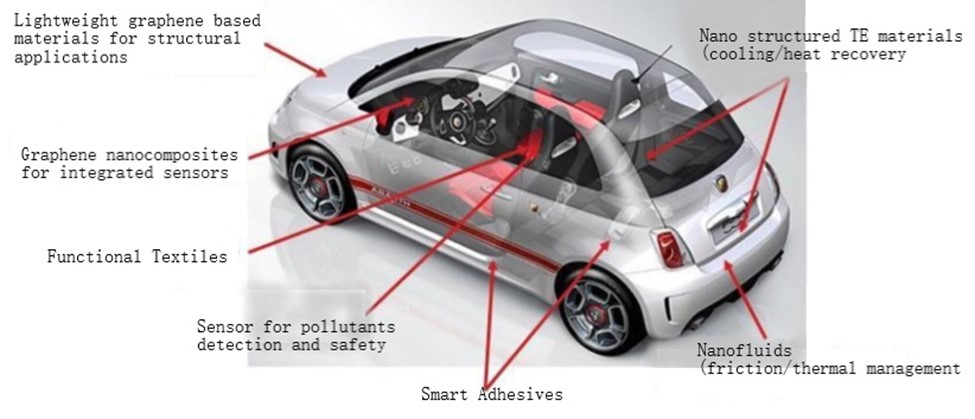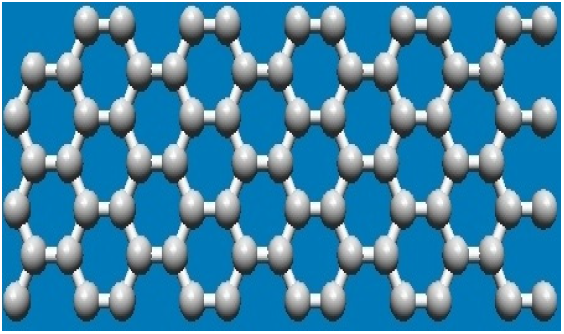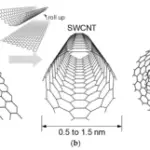Incessant researches are being carried out to ensure a beautiful, vibrant and improved life. And as a result of the non-ending researches, many strange things are being discovered and various mysterious unknowns are being revealed. Likewise, graphene is one of the amazing discoveries of the 21st century and attracted tremendous research interest. Today graphene with its unique properties is being used in a wide range of important areas from biomedical to wearable textiles. Information found from the researches done on graphene till today has been consolidated in this review paper though studies on graphene are still ongoing for its booming properties. It is obvious that graphene is certainly one of the most important discoveries in the Twenty-First Century. In the current research, it is observed that graphene is persistently revealing a new horizon in every single day. And that is why graphene has been mentioned as a miracle material in this review paper.
1. INTRODUCTION
Due to the relentless study of scientists, different kinds of unknowns are being known today and new wonders are being revealed. Today, People are starting to think that in this age of science, nothing is really impossible. It seems everything is within our hands. And that is being possible as a result of the ceaseless journey of rigorous researches on materials science. Likewise, graphene is one of the most remarkable discoveries of the 21st century. Graphene is a carbon allotrope consisting of tightly packed carbon atoms arranged in a 2D honeycomb lattice. It is a thin layer of graphite and this laminar material is usually used in pencil lead. Although some scattered attempts on graphene can be traced back to about 1899, two physicists named Andre Geim and Konstantin Novoselov from the University of Manchester, brought a major breakthrough in the field of material science by discovering the new process of graphene production in 2004. [1]
 |
| Figure 1: Honeycomb lattice structure of Graphene reprinted with permission [2] |
Graphene for its very amazing properties has become the pioneer in modern material science and technology. Graphene has drawn significant attention due to its exceptional electronic, mechanical, thermal and optical properties. [3-7] And all these properties are derived from the unique electrical band structure of graphene. Still different types of researches on graphene and its properties are being carried out. It has gifted and still gifting us so many dazzling applications in a wide range of fields. It is wise to employ these useful properties of graphene and its derivatives in various functional materials.[8] To date, graphene-based composites have been successfully made with inorganic nanostructures,[9-10] organic crystals,[11] polymers,[12-13] metal-organic frameworks (MOFs),[14-16] biomaterials,[17-18] and carbon nanotubes (CNTs)[19-20] and are intensively explored in applications such as batteries,[21-22] super-capacitors,[23] fuel cells,[24] photovoltaic devices, photocatalysis, sensing platforms.[25] These marvellous graphene properties along with their applications have been tried to be comprehensively presented in this review study.
2. GRAPHENE EXTRACTION
Graphene has been invented by a playful experiment done by two Russian scientists at the University of Manchester, named Andrei Geim and KostyaNovoselov. The main theme was to make the graphite films ‘as thin as possible’ and investigate their electronic properties. Sticky scotch tape was used to flake off a graphite layer from its body. Scientists did this peeling process repeatedly and finally succeeded to get down to a thin layer of about a few atoms.[26-29] Although there has been a significant advance in the study of graphene so far, no controlled method of getting crystalline and defects free graphene at large scale has been discovered yet. Many factors of graphene synthesis are under observations. It has been found that high-quality graphene can be synthesized by improving various parameters like temperatures, pressures, cooling rates, catalysts as well as the thickness of the catalysts etc.[30-33]
Graphene is the miracle material in the 21st century and that is why it could gather unbelievable research interests. As a consequence of rigorous research, various methods are now being developed and used to produce graphene. Some mostly used methods are Mechanical Exfoliation, Epitaxial Growth on Silicon Carbide, Chemical Vapour Deposition, Arc Discharge Method, Reduction of Graphite Oxide, intercalation methods in graphite, unzipping of CNTs, electrochemical and chemical methods, micromechanical cleavage method. [2, 34-37]
3. PROPERTIES
3.1 Electrical Transport Properties
Graphene is a 2-Dimensional and 1-Atom thick crystal consisting of sp2 hybridized carbon atoms which are arranged in a hexagonal lattice. Properties like High Charge Carrier Mobility, Ambipolar Field Effect, Anomalous Quantum Hall Effect, Ballistic Transport, Chirality and Weak Antilocation have made the graphene unparallel. Due to the electronic structure graphene has very high charge mobility. Generally, the mobility of graphene lies in between 2000–15000 cm2 v−1s−1. Very recently it has been found that graphene with a clean surface shows carrier mobility up to 200 000 cm2 v−1s−1.[37] Ambipolar field-effect is another crucial graphene property which has instigated its huge applications in electronics. Furthermore, the electronic structure of graphene results anomalous hall effect, chirality and weak antilocation properties.[38-39] The quantum anomalous Hall effect is an unorthodox demonstration of the topological structure of graphene and can be observed even at room temperature due to the high charge mobility.[40]
3.2 Optical Properties
Graphene has very good optical properties like very high optical transmittance, low optical reflectivity, luminescence, photoluminescence quenching properties and fluorescence quenching capability due to its distinctive electronic structures and energy or electron transfer. Interestingly single-layered and bilayered graphene shows different optical responses; that means graphene shows layer dependent optical transmission properties. It has been found that single-layer graphene has 97.4% optical transmittance and it decreases linearly with the number of layers.[40-41] Furthermore, luminescence and photoluminescence properties of graphene are successfully being utilized in various biological applications. [42-47] All these fascinating graphene properties have made it suitably fit for the advanced optical and optoelectronic applications.
3.3 Mechanical Properties
Graphene possesses some significant mechanical properties like high in-plane stiffness, highly versatile Young’s modulus and tensile strength due to the hexagonal 2-dimensional lattice consisting of sp2 hybridized C-C bonds.[48-49] Besides, mechanical properties of graphene are influenced by some other factors like- defects, no. of layers, stitching quality of adjacent boundaries and angle of tilt boundaries.[50] Below table shows a summary of the inherent mechanical properties of different layered graphene.
Table
1: Mechanical Properties of Graphene [51]
1: Mechanical Properties of Graphene [51]
3.4 Thermal Properties
Graphene manifests very good heat conveyor properties due to its elastic arrangement of atoms in the honeycomb tight compacted lattice. The thermal conductivity of graphene is about 5 × 103 Wm-1k-1, which is three times as high as diamond and higher than carbon nanotubes (CNT).[27][55] It has been demonstrated that the specific heat of graphene is bifurcated into atoms vibrations in the lattice (phonons) and free electron contributions. Specific heat, C = Cp + Ce; where Cp = Phonons’ contributions and Ce = free electrons’ contributions. Electrons’ contributions can play a significant role in doped materials, though phonons’ contribution is dominant in graphene generally. [56] Furthermore, the in-plane heat flow direction is always greater than the out-of-plane direction in graphene due to the hexagonal 2-dimensional lattice consisting of sp2 hybridized C-C bonds.
4. GRAPHENE-BASED POLYMER COMPOSITES
Wide range of polymer composites is available now based on different nanofillers like carbon nanotubes (CNTs), graphite, metal-oxides, nano-clay, nano-cellulose, carbon nanofiber (CNF) and graphene pellets (GPs) etc. both for thermoplastic and thermosetting polymer matrix materials. Commonly used matrix materials are thermoplastic matrix materials (polyethene, polypropylene, polystyrene, polyurethane etc.) and thermosetting matrix materials (epoxy, polyester, phenolic resin etc.).[57-60]
| Figure 2: Commonly used Graphene-based polymer composites |
5. APPLICATIONS OF GRAPHENE OR GRAPHENE-BASED COMPOSITES
Graphene has successfully attracted the researchers’ attention due to its fascinating properties and is being used in a wide range of fields. Very surprisingly it is expanding its territory day by day and has been established as a miracle material. This wonder material is still under research and every new day unlocks a new scope of application.
| Figure 3: Versatile Applications of Graphene |
5.1 Biomedical Applications
Researchers are working hard to figure out the existing deficiencies. They are seeking for easy and advanced diagnostics. Graphene has been discovered to use in precise biosensing, stem cell differentiation, cell proliferation & control, cancer treatment, drug delivery system and some other disease diagnostics.[61-62] Among the successful discoveries, some are really outstanding like- biocompatible hydrogel composite produced via physical cross-linking of PVA chains between graphene oxide (GO) platelets showed a controlled release of Vitamin B12 depending on solution pH, and it could be used in drug delivery, graphene oxide (GO) is used with biopolymers to improve their biocompatibility, mechanical strength, cell adhesion, and proliferation properties, specifically for various tissue engineering applications and very recently Graphene/PEG (Polyethylene Glycol)/Fe3O4 hybrid composite have been studied for applications on Magnetic Resonance Imaging (MRI) and Localized Photothermal Therapy of magnetically guided cancer cells.[63-67]
5.2 Electronics
Graphene has been able to occupy an important position in electronics. A number of electronic devices which are of time demand have been developed with the aid of graphene. Low-cost, easily recyclable display screens have been developed by using graphene instead of the indium-based electrode in OLED (Organic Light-Emitting Diode).[68] As electrons can move faster on graphene compared to silicon, Field Effect Transistors (FET) and High-frequency Transistors based on graphene could be refined. On top of that, in recent years researchers have successfully developed graphene-based transparent electrodes like organic thin-film transistors, touch screen, LEDs, solar cells, and smart windows etc.[69-71]
5.3 Energy Storage
Lithium-Ion Battery (LiB) is one of the most potential energy storage system. Its high absolute potential (about -3.04V) and low atomic weight (6.94gm/mol) leads to large energy density (up to ~400Wh/Kg).[72-73] LiB is very promising for especially portable electronics, power tools, and electric vehicles. Several metal oxides like TiO2, MnO2, CoO, NiO, VO2, V2O5, LiMn2O4, LiCoO2, SnO2, Co3O4, Fe3O4 are hybridized with graphene as an anode material for Lithium-ion Battery (LiB)s to improve its performance.[65,74] Very recently, the high energy efficiency of LiB is being used to improve the quality of energy produced from wind, solar, geothermal and other renewable sources.[75] Another important energy storage device is supercapacitor or electrochemical capacitors or ultracapacitors.[76] High power density (10KW/kg) and short charging-discharging time of these supercapacitors have created a wide range of applications, including load cranes, forklifts, electric vehicles, electric utilities, factory power backup and so on.[77-78]
5.4 Sensors
Graphene has been established as a potential sensor due to the change in conductance as a function of the extent of surface adsorption and large specific area. It can detect a variety of molecules such as gases to biomolecules.[60,79] It has been demonstrated that graphene and graphene-based polymer composites can also be used as a pH sensor, Pressure sensor and Temperature sensor.[43, 78–88]
5.5 Environmental Applications
Environmental pollution caused by both water and gases is the most issue in this present world. Everyone is seeking for ways to mitigate the environmental hazards and trying to develop new technologies if possible. Among the different approaches discovered to face environmental challenges, using nanomaterial has drawn pretty good interests.[89] Graphene-a 2D nanomaterial- has been used in environmental pollution management with an emphasis on gas adsorption and water remediation. Graphene and graphene-based composites are being used in water treatment membranes as well as pollutants removing electrode materials.[90] Furthermore, if the gasoline power transportations can be replaced by the graphene-based lithium battery (LiB), it would reduce the CO2 emission and thus reduce the environmental pollutions.
5.6 Automobile Applications
In this age of awareness, everybody is after ensuring getting safe and comfortable vehicles with minimum energy. Actually energy-efficient and safe vehicle means a lighter, less polluting and more fuel-efficient new generation vehicle.[36, 91] It has been demonstrated that for each 10% reduction in weight, lightweight material technology can improve vehicle fuel efficiency by 6–8%.[92] Graphene with its fantastic properties can be used in various parts of the vehicles (shown below).
| Figure 4: Potential applications of Graphene-based composite in a car reprinted with permission [92] |
5.7 Textile Applications
In recent years smart textiles (e-textiles) have drawn tremendous research interest and are the most promising especially for sportswear, medical textiles and military applications.[93] There exists a lot of methods of producing e-textiles but unfortunately, none of these is eco-friendly nor cost-effective. Graphene inks have been demonstrated to be the promising candidate to eradicate such kinds of problems. Graphene inks can be applied on textiles by ink-jet printing instead of incorporating various electronic devices on textiles.[94-98] Furthermore, very recently a team from the University of Manchester have discovered a scalable and more importantly cost-effective graphene-based e-textiles manufacturing process which has secured the firm position of graphene in e-textile applications.[99] A pretty good number of researches has been fruitfully carried out to ensure e-textiles as conductive as well as strong, highly elastic, mechanically flexible, wearable, and lightweight.[100–104]
6. FINDINGS AND CONCLUSION
The properties of graphene provide basically vast potential for various applications. Graphene and Graphene-based composites have occupied a huge place in advanced engineering applications including energy conversion, energy storage, transparent electrodes, biological and biomedical, etc. Due to the tremendous consumption of limited energy, the earth is forwarding towards future energy crisis and many environmental imbalances. Graphene, for its outstanding electrical conductivity, high specific surface area, and good structural stability, have taken our focus to mitigate this energy and other environmental challenges. Aforementioned review study reveals that graphene is the most promising potential candidate for next-generation materials as well that are being sought immensely for a smooth future. The structure and associated properties of graphene have proved itself as a miracle material indeed.
Acknowledgements
We would like to convey our heartfelt gratitude to Marzia Dulal (Assistant Professor at Bangladesh University of Textiles) and Mr Sudip Dey (Assistant Manager, Sparkle Colors (Agent for Dystar), Bangladesh) who has supported us in literature collection and critical analysis.
CONFLICTING INTERESTS
There is no potential conflicts of interest with respect to the research, authorship, and/or publication of this article.
FUNDING
There is no funding agency used for this research. This is a self-funded work.
REFERENCES
[1] K. S. Novoselov, A. K. Geim, S. V Morozov, and D. Jiang, “PGR Tips on writing effective CVs,” Phys. Rev. Lett, vol. 306, no. 52, pp. 666–669, 2004.
[2] J. U. Arikpo and M. U. Onuu, “Graphene Growth and Characterization : Advances , Present Challenges and Prospects,” vol. 8, no. 4, pp. 37–68, 2019.
[3] G. Eda, G. Fanchini, and M. Chhowalla, “Large-area ultrathin films of reduced graphene oxide as a transparent and flexible electronic material,” Nat. Nanotechnol., vol. 3, no. 5, pp. 270–274, 2008.
[4] Q. Wu, Y. Xu, Z. Yao, A. Liu, and G. Shi, “Supercapacitors based on flexible graphene/polyaniline nanofiber composite films,” ACS Nano, vol. 4, no. 4, pp. 1963–1970, 2010.
[5] F. Schedin et al., “Detection of individual gas molecules adsorbed on graphene,” Nat. Mater., vol. 6, no. 9, pp. 652–655, 2007.
[6] C. Lee, X. Wei, J. W. Kysar, and J. Hone, “Measurement of the elastic properties and intrinsic strength of monolayer graphene,” Science (80-. )., vol. 321, no. 5887, pp. 385–388, 2008.
[7] N. Xiao et al., “ACS Nano 2011 Xiao N.pdf,” no. 4, pp. 2749–2755, 2011.
[8] X. Huang, X. Qi, F. Boey, and H. Zhang, “Graphene-based composites,” 2011.
[9] S. Wu, Z. Yin, Q. He, X. Huang, X. Zhou, and H. Zhang, “Electrochemical Deposition of Semiconductor Oxides on Reduced Graphene Oxide-Based Flexible, Transparent, and Conductive Electrodes,” J. Phys. Chem. C, vol. 114, no. 27, pp. 11816–11821, Jul. 2010.
[10] Ryan Muszynski, and Brian Seger, and P. V. Kamat*, “Decorating Graphene Sheets with Gold Nanoparticles,” 2008.
[11] T. H. Han, W. J. Lee, D. H. Lee, J. E. Kim, E.-Y. Choi, and S. O. Kim, “Peptide/Graphene Hybrid Assembly into Core/Shell Nanowires,” Adv. Mater., vol. 22, no. 18, pp. 2060–2064, Mar. 2010.
[12] T. Ramanathan et al., “Functionalized graphene sheets for polymer nanocomposites,” Nat. Nanotechnol., vol. 3, no. 6, pp. 327–331, Jun. 2008.
[13] H. Yang, Q. Zhang, C. Shan, F. Li, D. Han, and L. Niu, “Stable, Conductive Supramolecular Composite of Graphene Sheets with Conjugated Polyelectrolyte,” Langmuir, vol. 26, no. 9, pp. 6708–6712, May 2010.
[14] M. Jahan, Q. Bao, J.-X. Yang, and K. P. Loh, “Structure-Directing Role of Graphene in the Synthesis of Metal−Organic Framework Nanowire,” J. Am. Chem. Soc., vol. 132, no. 41, pp. 14487–14495, Oct. 2010.
[15] C. Petit and T. J. Bandosz, “Enhanced Adsorption of Ammonia on Metal-Organic Framework/Graphite Oxide Composites: Analysis of Surface Interactions,” Adv. Funct. Mater., vol. 20, no. 1, pp. 111–118, Jan. 2010.
[16] C. Petit, J. Burress, and T. J. Bandosz, “The synthesis and characterization of copper-based metal–organic framework/graphite oxide composites,” Carbon N. Y., vol. 49, no. 2, pp. 563–572, Feb. 2011.
[17] C. Lu, H. Yang, C. Zhu, X. Chen, and G. Chen, “A Graphene Platform for Sensing Biomolecules,” Angew. Chemie, vol. 121, no. 26, pp. 4879–4881, Jun. 2009.
[18] H. Chang, L. Tang, Y. Wang, J. Jiang, and J. Li, “Graphene Fluorescence Resonance Energy Transfer Aptasensor for the Thrombin Detection,” Anal. Chem., vol. 82, no. 6, pp. 2341–2346, Mar. 2010.
[19] X. Dong et al., “One-step growth of graphene–carbon nanotube hybrid materials by chemical vapor deposition,” Carbon N. Y., vol. 49, no. 9, pp. 2944–2949, Aug. 2011.
[20] V. C. Tung et al., “Low-Temperature Solution Processing of Graphene−Carbon Nanotube Hybrid Materials for High-Performance Transparent Conductors,” Nano Lett., vol. 9, no. 5, pp. 1949–1955, May 2009.
[21] S. Yang, X. Feng, S. Ivanovici, and K. Müllen, “Fabrication of Graphene-Encapsulated Oxide Nanoparticles: Towards High-Performance Anode Materials for Lithium Storage,” Angew. Chemie Int. Ed., vol. 49, no. 45, pp. 8408–8411, Nov. 2010.
[22] H. Wang et al., “Mn 3 O 4 −Graphene Hybrid as a High-Capacity Anode Material for Lithium Ion Batteries,” J. Am. Chem. Soc., vol. 132, no. 40, pp. 13978–13980, Oct. 2010.
[23] F. Kim, J. Luo, R. Cruz-Silva, L. J. Cote, K. Sohn, and J. Huang, “Self-Propagating Domino-like Reactions in Oxidized Graphite,” Adv. Funct. Mater., vol. 20, no. 17, pp. 2867–2873, Sep. 2010.
[24] R. Imran Jafri et al., “Nitrogen doped graphene nanoplatelets as catalyst support for oxygen reduction reaction in proton exchange membrane fuel cell,” J. Mater. Chem., vol. 20, no. 34, p. 7114, Aug. 2010.
[25] X. Li et al., “Graphene-On-Silicon Schottky Junction Solar Cells,” Adv. Mater., vol. 22, no. 25, pp. 2743–2748, Jul. 2010.
[26] A. K. Geim, “Graphene prehistory,” Phys. Scr., vol. 014003, no. T146, 2012.
[27] F. Ebrahimi and E. Heidari, “A Review on Modeling, Synthesis, and Properties of Graphene,” in Graphene: New trends and Developments, F. Ebrahimi, Ed. AvE4EvA, 2015, pp. 4,5,7, 9.
[28] I. A. Ovid’ko, “Mechanical properties of graphene,” Rev. Adv. Mater. Sci., vol. 34, no. 1, pp. 2, 4, 2013.
[29] “The graphene story: how Andrei Geim and Kostya Novoselov hit on a scientific breakthrough that changed the world… by playing with sticky tape | The Independent.” [Online]. Available: https://www.independent.co.uk/news/science/the-graphene-story-how-andrei-geim-and-kostya-novoselov-hit-on-a-scientific-breakthrough-that-8539743.html. [Accessed: 02-Dec-2019].
[30] A. Kumar, A. A. Voevodin, D. Zemlyanov, D. N. Zakharov, and T. S. Fisher, “Rapid synthesis of few-layer graphene over Cu foil,” Carbon N. Y., vol. 50, no. 4, pp. 1546–1553, 2012.
[31] J. Zhang, P. A. Hu, X. Wang, and Z. Wang, “Structural evolution and growth mechanism of graphene domains on copper foil by ambient pressure chemical vapor deposition,” Chem. Phys. Lett., vol. 536, pp. 123–128, 2012.
[32] J. Kraus et al., “Towards the perfect graphene membrane? – Improvement and limits during formation of high quality graphene grown on Cu-foils,” Carbon N. Y., vol. 64, pp. 377–390, 2013.
[33] M. Sarno, C. Cirillo, R. Piscitelli, and P. Ciambelli, “A study of the key parameters, including the crucial role of H2 for uniform graphene growth on Ni foil,” J. Mol. Catal. A Chem., vol. 366, pp. 303–314, 2013.
[34] K. Ojha, O. Anjaneyulu, and A. K. Ganguli, “Graphene-based hybrid materials: Synthetic approaches and properties,” Curr. Sci., vol. 107, no. 3, pp. 397, 402–11, 2014.
[35] R. Ramachandran, V. Mani, S.-M. Chen, R. Saraswathi, and B.-S. Lou, “Recent Trends in Graphene based Electrode Materials for Energy Storage Devices and Sensors Applications,” Int. J. Electrochem. Sci., vol. 8, pp. 11681,11686, 11691, 2013.
[36] P. Mukhopadhyay and Gupta Rakesh K., “Trends and Frontiers in Graphene-Based Polymer Nanocomposites,” John Wiley & Sons, Inc, no. PLASTICS ENGINEERING, pp. 32, 36, Jan-2011.
[37] H. Chang and H. Wu, “Graphene-based nanomaterials: Synthesis, properties, and optical and optoelectronic applications,” Adv. Funct. Mater., 2013.
[38] A. J. Pollard et al., “Formation of monolayer graphene by annealing sacrificial nickel thin films,” J. Phys. Chem. C, vol. 113, no. 38, pp. 16565–16567, 2009.
[39] A. H. Castro Neto, F. Guinea, N. M. R. Peres, K. S. Novoselov, and A. K. Geim, “The electronic properties of graphene,” 2009.
[40] K. Ojha, O. Anjaneyulu, and A. K. Ganguli, “Graphene-based hybrid materials: synthetic approaches and properties,” 2014.
[41] S. Bae et al., “Roll-to-roll production of 30-inch graphene films for transparent electrodes,” Nat. Nanotechnol., vol. 5, no. 8, pp. 574–578, 2010.
[42] H. Chang, L. Tang, Y. Wang, J. Jiang, and J. Li, “Graphene fluorescence resonance energy transfer aptasensor for the thrombin detection,” Anal. Chem., vol. 82, no. 6, pp. 2341–2346, 2010.
[43] R. Cui, Z. Han, J. Pan, E. S. Abdel-Halim, and J. J. Zhu, “Direct electrochemistry of glucose oxidase and biosensing for glucose based on helical carbon nanotubes modified magnetic electrodes,” Electrochim. Acta, vol. 58, no. 1, pp. 179–183, 2011.
[44] X. Yan, X. Cui, B. Li, and L. S. Li, “Large, solution-processable graphene quantum dots as light absorbers for photovoltaics,” Nano Lett., vol. 10, no. 5, pp. 1869–1873, 2010.
[45] C. Peng, W. Hu, Y. Zhou, C. Fan, and Q. Huang, “Intracellular imaging with a graphene-based fluorescent probe,” Small, vol. 6, no. 15, pp. 1686–1692, 2010.
[46] Y. Li et al., “An electrochemical avenue to green-luminescent graphene quantum dots as potential electron-acceptors for photovoltaics,” Adv. Mater., vol. 23, no. 6, pp. 776–780, 2011.
[47] D. Pan, J. Zhang, Z. Li, and M. Wu, “Hydrothermal route for cutting graphene sheets into blue-luminescent graphene quantum dots,” Adv. Mater., vol. 22, no. 6, pp. 734–738, 2010.
[48] A. C. Ferrari et al., “Science and technology roadmap for graphene, related two-dimensional crystals, and hybrid systems,” Nanoscale, p. 11,20,24, 2014.
[49] M. Aliofkhazraei, N. Ali, W. I. Milne, C. S. Ozkan, S. Mitura, and J. L. Gervasoni, Graphene science handbook: Mechanical and chemical properties. 2016.
[50] Y. Zhong, Z. Zhen, and H. Zhu, “Graphene: Fundamental research and potential applications,” FlatChem, vol. 4, pp. 20–32, 2017.
[51] Reprinted from “V. Singh, D. Joung, L. Zhai, S. Das, S. I. Khondaker, and S. Seal, “Graphene based materials: Past, present and future,” Prog. Mater. Sci., vol. 56, pp. 1181–83, 1207–15, 2011.” copyright (2019) with permission from Elsevier.
[52] C. Lee, X. Wei, J. W. Kysar, and J. Hone, “of Monolayer Graphene,” vol. 321, no. July, pp. 385–388, 2008.
[53] G. Tsoukleri et al., “Subjecting a graphene monolayer to tension and compression,” Small, vol. 5, no. 21, pp. 2397–2402, 2009.
[54] C. Lee, X. Wei, Q. Li, R. Carpick, J. W. Kysar, and J. Hone, “Elastic and frictional properties of graphene,” Phys. Status Solidi Basic Res., vol. 246, no. 11–12, pp. 2562–2567, 2009.
[55] X. Li, Synthesis, Properties and Application of Graphene Woven Fabrics. 2015.
[56] A. A. Balandin, “Thermal properties of graphene and nanostructured carbon materials,” Nat. Mater., vol. 10, no. 8, pp. 569–581, 2011.
[57] Q. Li, O. K. Park, and J. H. Lee, “Positive temperature coefficient behavior of HDPE/EVA blends filled with carbon black,” Adv. Mater. Res., vol. 79–82, pp. 2267–2270, 2009.
[58] X. Chen, Y. P. Zheng, F. Kang, and W. C. Shen, “Preparation and structure analysis of carbon/carbon composite made from phenolic resin impregnation into exfoliated graphite,” J. Phys. Chem. Solids, vol. 67, no. 5–6, pp. 1141–1144, 2006.
[59] K. Chrissafis, K. M. Paraskevopoulos, S. Y. Stavrev, A. Docoslis, A. Vassiliou, and D. N. Bikiaris, “Characterization and thermal degradation mechanism of isotactic polypropylene/carbon black nanocomposites,” Thermochim. Acta, vol. 465, no. 1–2, pp. 6–17, 2007.
[60] T. K. Das and S. Prusty, “Graphene-Based Polymer Composites and Their Applications,” Polym. – Plast. Technol. Eng., vol. 52, no. 4, pp. 319–331, 2013.
[61] X. Sun et al., “Nano-graphene oxide for cellular imaging and drug delivery,” Nano Res., vol. 1, no. 3, pp. 203–212, 2008.
[62] Z. Liu, J. T. Robinson, X. Sun, and H. Dai, “PEGylated nanographene oxide for delivery of water-insoluble cancer drugs,” J. Am. Chem. Soc., vol. 130, no. 33, pp. 10876–10877, 2008.
[63] Y. Zhang, T. R. Nayak, H. Hong, and W. Cai, “Graphene: A versatile nanoplatform for biomedical applications,” Nanoscale, vol. 4, no. 13, pp. 3833–3842, 2012.
[64] C. Chung, Y. K. Kim, D. Shin, S. R. Ryoo, B. H. Hong, and D. H. Min, “Biomedical applications of graphene and graphene oxide,” Acc. Chem. Res., vol. 46, no. 10, pp. 2211–2224, 2013.
[65] M. Khan et al., “Graphene based metal and metal oxide nanocomposites: synthesis, properties and their applications,” J. Mater. Chem. A, vol. 3, no. 37, pp. 18753–18808, 2015.
[66] M. K. Satapathy, W.-H. Chiang, E.-Y. Chuang, C.-H. Chen, J.-L. Liao, and H.-N. Huang, “Microplasma-assisted hydrogel fabrication: A novel method for gelatin-graphene oxide nano composite hydrogel synthesis for biomedical application,” PeerJ, vol. 5, Jun. 2017.
[67] L. Feng, L. Wu, and X. Qu, “New horizons for diagnostics and therapeutic applications of graphene and graphene oxide,” Adv. Mater., vol. 25, no. 2, pp. 168–186, 2013.
[68] K. Ojha, O. Anjaneyulu, and A. K. Ganguli, “SPECIAL SECTION : CARBON TECHNOLOGY Graphene-based hybrid materials : synthetic approaches and properties,” Curr. Sci., vol. 107, no. 3, pp. 397–418, 2014.
[69] A. Chavez-Valdez, M. S. P. Shaffer, and A. R. Boccaccini, “Applications of graphene electrophoretic deposition. A review,” J. Phys. Chem. B, vol. 117, no. 6, pp. 1502–1515, 2013.
[70] Y. Huang, J. Liang, and Y. Chen, “An overview of the applications of graphene-based materials in supercapacitors,” Small, vol. 8, no. 12, pp. 1805–1834, 2012.
[71] S. Bae, S. J. Kim, D. Shin, J. H. Ahn, and B. H. Hong, “Towards industrial applications of graphene electrodes,” Phys. Scr., no. T146, 2012.
[72] M. R. Palacín, “Recent advances in rechargeable battery materials: A chemist’s perspective,” Chem. Soc. Rev., vol. 38, no. 9, pp. 2565–2575, 2009.
[73] J. A. Parellada, M. M. Dunn, A. Wayland, J. Cousins, and E. Shaw de Paredes, “Patient tracking and follow-up after percutaneous breast biopsy,” Appl. Radiol., vol. 26, no. 2, pp. 7–10, 1997.
[74] S. Muhammad Nawaz Tahir et al., “www.rsc.org/MaterialsA As featured in: Graphene based metal and metal oxide nanocomposites: synthesis, properties and their applications,” J. Mater. Chem. A Mater. energy Sustain., vol. 3, 2015.
[75] N. Nitta, F. Wu, J. T. Lee, and G. Yushin, “Li-ion battery materials: Present and future,” Mater. Today, vol. 18, no. 5, pp. 252–264, 2015.
[76] Z. Hu, Z. Zhengquan, and J. Mao, “Silicon and reduced graphene oxide employed as additives to enhance the performances of artificial graphite anode for lithium-ion battery,” Fullerenes Nanotub. Carbon Nanostructures, vol. 0, no. 0, pp. 1–8, 2019.
[77] Y. Wang et al., “Supercapacitor devices based on graphene materials,” J. Phys. Chem. C, vol. 113, no. 30, pp. 13103–13107, 2009.
[78] M. Pumera, “Graphene-based nanomaterials for energy storage,” Energy Environ. Sci., vol. 4, no. 3, pp. 668–674, 2011.
[79] F. A. Ghavanini and H. Theander, “Graphene Feasibility and Foresight Study for Transport Infrastructures,” Chalmers Ind., pp. 1–45, 2015.
[80] X. Kang, J. Wang, H. Wu, I. A. Aksay, J. Liu, and Y. Lin, “Glucose Oxidase-graphene-chitosan modified electrode for direct electrochemistry and glucose sensing,” Biosens. Bioelectron., vol. 25, no. 4, pp. 901–905, 2009.
[81] I. Erukhimovich and M. O. de la Cruz, “Phase equilibria and charge fractionation in polydisperse polyelectrolyte solutions,” no. February, pp. 888–897, 2004.
[82] R. Xue, T. F. Kang, L. P. Lu, and S. Y. Cheng, “Electrochemical Sensor Based on the Graphene-Nafion Matrix for Sensitive Determination of Organophosphorus Pesticides,” Anal. Lett., vol. 46, no. 1, pp. 131–141, 2012.
[83] T. T. Baby, S. S. J. Aravind, T. Arockiadoss, R. B. Rakhi, and S. Ramaprabhu, “Metal decorated graphene nanosheets as immobilization matrix for amperometric glucose biosensor,” Sensors Actuators, B Chem., vol. 145, no. 1, pp. 71–77, 2010.
[84] C. Xu, X. Wang, J. Wang, H. Hu, and L. Wan, “Synthesis and photoelectrical properties of β-Cyclodextrin functionalized graphene materials with high bio-recognition capability,” Chem. Phys. Lett., vol. 498, no. 1–3, pp. 162–167, 2010.
[85] Y. C. Yang et al., “A Label-Free Amperometric Immunoassay for Thrombomodulin Using Graphene/Silver-Silver Oxide Nanoparticles as a Immobilization Matrix,” Anal. Lett., vol. 45, no. 7, pp. 724–734, 2012.
[86] H. Lian, Z. Sun, X. Sun, and B. Liu, “Graphene Doped Molecularly Imprinted Electrochemical Sensor for Uric Acid,” Anal. Lett., vol. 45, no. 18, pp. 2717–2727, 2012.
[87] H. Yin et al., “Electrochemical oxidation behavior of guanine and adenine on graphene-Nafion composite film modified glassy carbon electrode and the simultaneous determination,” Process Biochem., vol. 45, no. 10, pp. 1707–1712, 2010.
[88] H. Wu et al., “Glucose biosensor based on immobilization of glucose oxidase in platinum nanoparticles/graphene/chitosan nanocomposite film,” Talanta, vol. 80, no. 1, pp. 403–406, 2009.
[89] F. Perreault, A. Fonseca De Faria, and M. Elimelech, “Environmental applications of graphene-based nanomaterials,” Chem. Soc. Rev., vol. 44, no. 16, pp. 5861–5896, 2015.
[90] K. C. Kemp et al., “Environmental applications using graphene composites: Water remediation and gas adsorption,” Nanoscale, vol. 5, no. 8, pp. 3149–3171, 2013.
[91] “Downloaded from: http://sure.sunderland.ac.uk/id/eprint/5458/,” no. September, 2015.
[92] A. Elmarakbi and W. L. Azoti, “NOVEL COMPOSITE MATERIALS FOR AUTOMOTIVE APPLICATIONS: CONCEPTS AND CHALLENGES FOR ENERGY-EFFICIENT AND SAFE VEHICLES,” in 10th International Conference on Composite Science and Technology, 2015, p. 1,4.
[93] M. S. Sarif Ullah Patwary, “Smart Textiles and Nano-Technology: A General Overview,” J. Text. Sci. Eng., vol. 05, no. 01, 2015.
[94] A. M. Abdelkader, N. Karim, C. Vallés, S. Afroj, K. S. Novoselov, and S. G. Yeates, “Ultraflexible and robust graphene supercapacitors printed on textiles for wearable electronics applications,” 2D Mater., vol. 4, no. 3, 2017.
[95] G. Yu et al., “Solution-processed graphene/MnO2 nanostructured textiles for high-performance electrochemical capacitors,” Nano Lett., vol. 11, no. 7, pp. 2905–2911, 2011.
[96] Y. Meng et al., “All-graphene core-sheath microfibers for all-solid-state, stretchable fibriform supercapacitors and wearable electronic textiles,” Adv. Mater., vol. 25, no. 16, pp. 2326–2331, 2013.
[97] L. Liu, Y. Yu, C. Yan, K. Li, and Z. Zheng, “Wearable energy-dense and power-dense supercapacitor yarns enabled by scalable graphene-metallic textile composite electrodes,” Nat. Commun., vol. 6, pp. 1–9, 2015.
[98] N. Karim et al., “All inkjet-printed graphene-based conductive patterns for wearable e-textile applications,” J. Mater. Chem. C, vol. 5, no. 44, pp. 11640–11648, 2017.
[99] N. Karim et al., “Scalable Production of Graphene-Based Wearable E-Textiles,” ACS Nano, vol. 11, no. 12, pp. 12266–12275, Dec. 2017.
[100] W. Gu and Y. Zhao, “Graphene modified cotton textiles,” Adv. Mater. Res., vol. 331, pp. 93–96, 2011.
[101] M. Shateri-Khalilabad and M. E. Yazdanshenas, “Fabricating electroconductive cotton textiles using graphene,” Carbohydr. Polym., vol. 96, no. 1, pp. 190–195, 2013.
[102] T. Salan and A. Mehmet, “Graphene Applied Textile Materials For Wearable E-Textiles GRAPHENE APPLIED TEXTILE MATERIALS FOR WEARABLE E- TEXTILES,” no. May 2016, 2015.
[103] S. H. Aboutalebi et al., “High-performance multifunctional Graphene yarns: Toward wearable all-carbon energy storage textiles,” ACS Nano, vol. 8, no. 3, pp. 2456–2466, 2014.
[104] Y. J. Yun, W. G. Hong, W. J. Kim, Y. Jun, and B. H. Kim, “A novel method for applying reduced graphene oxide directly to electronic textiles from yarns to fabrics,” Adv. Mater., vol. 25, no. 40, pp. 5701–5705, 2013.
Texpedi.com
Check out these related articles:









This comment has been removed by a blog administrator.